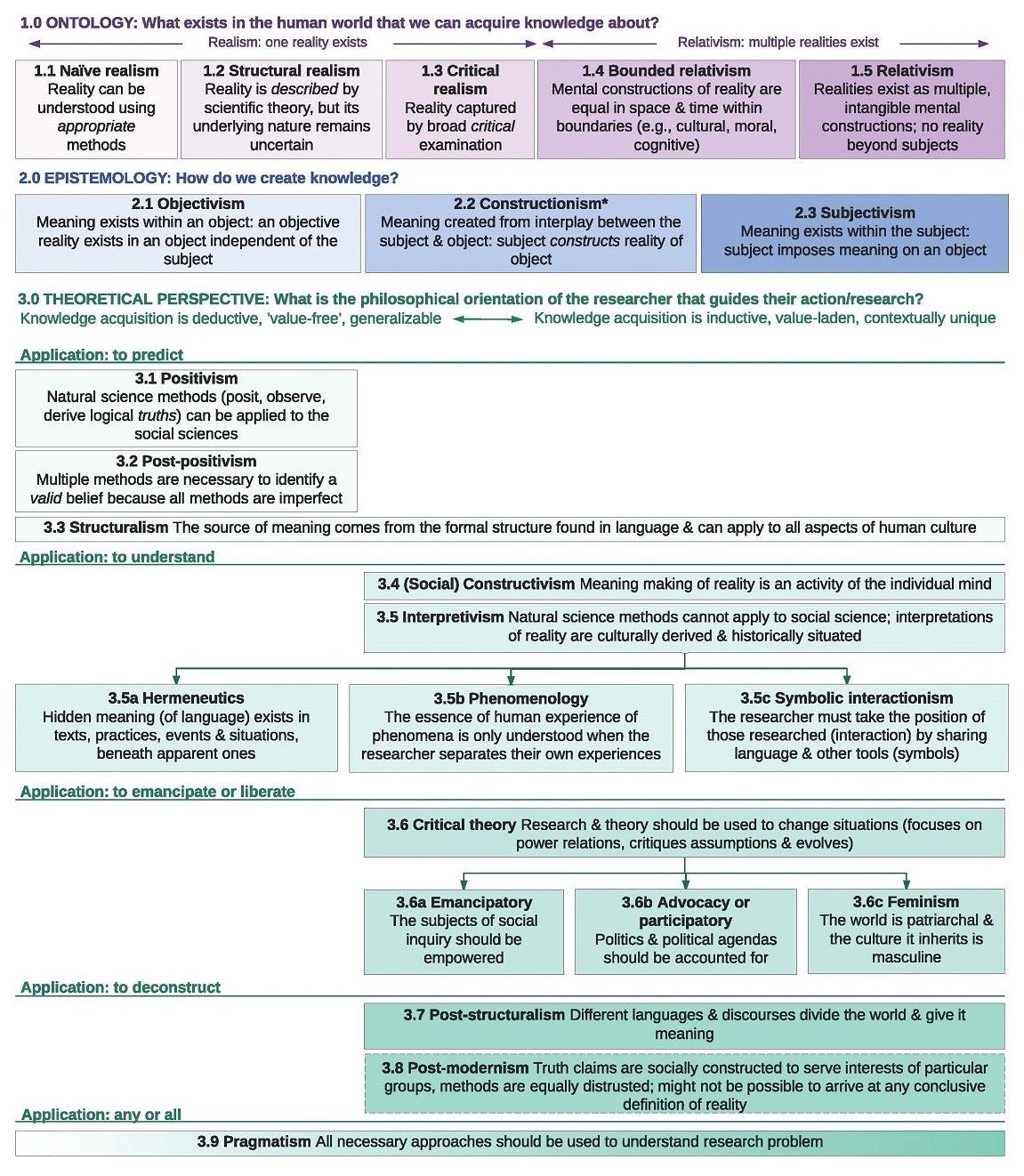Social science research can sometimes seem opaque to natural scientists. This guide offers a philosophical framework to navigate and interpret social science research effectively, improving interdisciplinary collaborations and research outcomes. Understanding the underlying philosophical assumptions that shape research design and interpretation is crucial for all researchers, but especially for those working across disciplinary boundaries.
Social science research interpretation hinges on understanding the choices made during the research process. These choices, often unknowingly, stem from core philosophical principles. Let’s explore the key branches of philosophy relevant to social science, providing a framework for natural scientists to better understand and engage with this field.
The figure below illustrates three major branches of philosophy that influence scientific research.
 Social science research guide consisting of ontology, epistemology, and philosophical perspectives. When read from left to right, elements take on a more multidimensional nature (eg., epistemology: objectivism to subjectivism). The elements within each branch are positioned according to their congruence with elements from other branches so when read from top to bottom (or bottom to top), elements from one branch align with elements from another (eg., critical realist ontology, constructionist epistemology, and interpretivist philosophical perspectives). Subcategories of elements (ie., 3.5a–c and 3.6a–c) are to be interpreted as positioned under the parent category (ie., 3.5 interpretivism and 3.6 critical theory).
Social science research guide consisting of ontology, epistemology, and philosophical perspectives. When read from left to right, elements take on a more multidimensional nature (eg., epistemology: objectivism to subjectivism). The elements within each branch are positioned according to their congruence with elements from other branches so when read from top to bottom (or bottom to top), elements from one branch align with elements from another (eg., critical realist ontology, constructionist epistemology, and interpretivist philosophical perspectives). Subcategories of elements (ie., 3.5a–c and 3.6a–c) are to be interpreted as positioned under the parent category (ie., 3.5 interpretivism and 3.6 critical theory).
Ontology: Exploring the Nature of Reality
Ontology, the “study of being,” investigates what exists and how we can acquire knowledge about it. It compels researchers to consider the certainty with which they can understand the objects of their research. Key questions in ontology include:
- What “truth claims” can be made about reality?
- Who decides the legitimacy of what is considered “real”?
- How do researchers address differing and conflicting views of reality?
Consider the difference between realist and relativist ontologies. Realist ontology posits a single, independent reality that can be studied and understood objectively. Relativist ontology, conversely, argues that reality is constructed within the human mind, varying based on individual experiences and contexts. Understanding a researcher’s ontological stance is vital for interpreting their findings.
Epistemology: Examining the Nature of Knowledge
Epistemology, the “study of knowledge,” explores the validity, scope, and methods of acquiring knowledge. It addresses questions such as:
- What constitutes a valid knowledge claim?
- How is knowledge acquired or produced?
- How can the transferability of knowledge be assessed?
Epistemology influences how researchers frame their investigations and seek to uncover knowledge. Consider the relationship between the researcher (subject) and the object of study.
Objectivist epistemology assumes reality exists independently of the individual mind. This approach emphasizes reliability (consistency of results) and external validity (applicability to other contexts).
Constructionist epistemology challenges the idea of an objective “truth” waiting to be discovered. Instead, meaning emerges from our interactions with the world. A “real world” does not pre-exist independently of human activity or symbolic language. This approach focuses on generating contextual understandings of a specific topic or problem.
Subjectivist epistemology suggests that reality is shaped by individual interpretations and symbol systems. People impose meaning on the world based on their experiences. For instance, a scuba diver’s interpretation of a shadow in the water depends on their prior experiences and expectations (e.g., shark, boat, weather change). Subjectivist research aims to reveal how individual experiences shape perceptions of the world.
Philosophical Perspectives: Guiding Research Action
Philosophical perspectives, derived from ontology and epistemology, represent generalized worldviews that shape beliefs and guide actions.
These perspectives are crucial because they reveal the assumptions researchers make about their work. These assumptions influence choices regarding the research purpose, design, methodology, methods, data analysis, and interpretation. Even the choice of what to study reflects underlying values.
For example, a positivist perspective, rooted in realist ontology and objectivist epistemology, favors quantitative methods and seeks to establish causal relationships. An interpretivist perspective, informed by relativist ontology and subjectivist epistemology, often employs qualitative methods to understand individual experiences and meanings.
Conclusion: Enhancing Interdisciplinary Research
Understanding the philosophical underpinnings of science is essential for meaningful interpretation of research outcomes. As interdisciplinary research grows, examining the differences and intersections between philosophical approaches fosters critical reflection and debate about what we can know, learn, and how this knowledge influences scientific conduct and subsequent decisions.
Consider how your own philosophical standpoint influences your research. Reflect on experiences where philosophical perspectives clashed in interdisciplinary projects. By recognizing these differences, researchers can improve communication, collaboration, and the overall quality of interdisciplinary research.
Further Reading:
Moon, K., and Blackman, D. (2014). A Guide To Understanding Social Science Research For Natural Scientists. Conservation Biology, 28: 1167-1177. Online: https://onlinelibrary.wiley.com/doi/10.1111/cobi.12326/full
